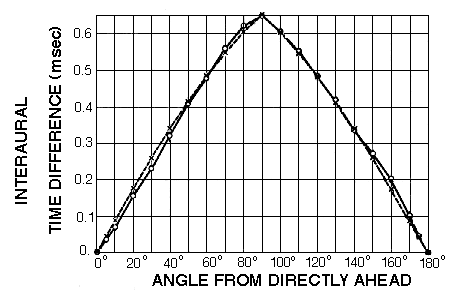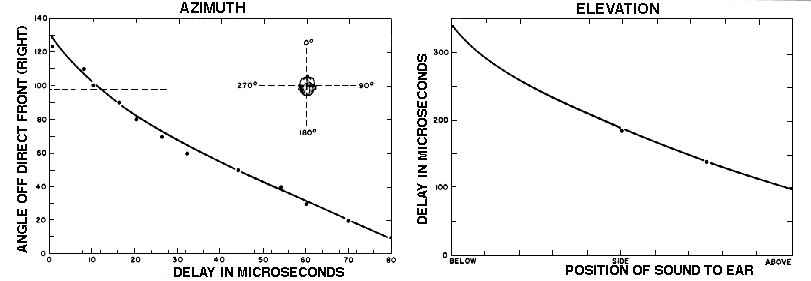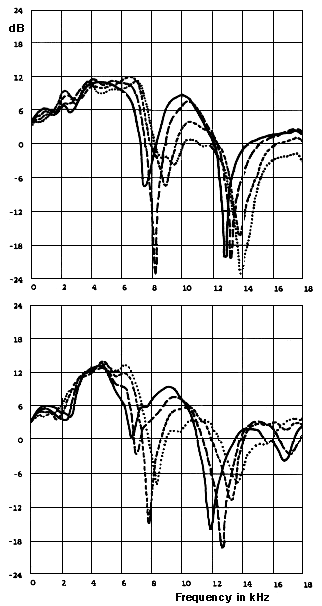Literally, to hear with two ears. Opposite of MONAURAL HEARING. The fact that the ears are some distance apart allows the localization of sound by registering the slight differences in time, PHASE and INTENSITY of the sound striking each ear. Each of these parameters has a different area of effect, intensity being a major factor above 1500 Hz (see SOUND SHADOW), while PHASE DIFFERENCEs (which are equivalent to time differences) are used in localizing lower frequency sounds.
The ear can detect a time difference as slight as 30 microseconds and smaller differences through training. The maximum time lag for sound generated at one side of the head is around 0.6 milliseconds (see diagram below).
See: AZIMUTH, COCKTAIL PARTY EFFECT, ECHOLOCATION, MINIMUM AUDIBLE ANGLE, PRECEDENCE EFFECT.
Front-back distinctions are not uniquely determined by time differences, but rather by the PINNAE of the outer ear REFLECTing sound differently for positions around the listener. Similarly, a so-called cone of confusion exists at each side of the head creating localization ambiguities for points located on the circumference of the cone. These pinna reflections result in CANCELLATION in the very high frequency range, such spectral colouration being described as the head-related transfer function (HRTF) as shown in the diagrams below.
Sounds heard with both ears may be called diotic, whereas those heard independently by each ear via headphones are called DICHOTIC.
See: KUNSTKOPF, PAN, STEREOACUSIS, STEREOPHONIC. Compare: ACOUSTIC SPACE, PHASING, PRESBYCUSIS.

Interaural time difference as a function of the direction of the source of clicks. The solid line denotes measured values for five subjects; the dashed line shows theoretical values computed from a sphere (from Mills, "Auditory Localization", in Tobias, ed., Foundations of Modem Auditory Theory, Academic Press, 1972, p.305, used by permission).
![]() Sound
Example: Localization of a sound from
left to right using only binaural time delays (heard only on
headphones).
Sound
Example: Localization of a sound from
left to right using only binaural time delays (heard only on
headphones).

Time delays of reflections from the ridges of the pinna. The first chart (left) shows the delays (in microseconds) caused by reflections from the inner pinna ridge which determine front-back directions in the horizontal plane. The other chart (right) shows delays from the outer pinna rim which are important in determining elevation in the vertical plane. The measurements were made on a 5x scale model and reduced to human pinnae size (after Batteau and Plante, from A.W. Mills, "Auditory Localization", in J.V. Tobias, ed., Foundations of Modem Auditory Theory, Academic Press, 1972, vol. 2, p.337, used by permission).

Head-related transfer functions (HRTF) for two subjects illustrating spectral colouration for increasing source elevation in the lateral plane. The sound was located 2 meters to the left of the subject and was moved from ear level (0 degrees) to an elevation 30 degrees above ear level (solid line: 0 degrees; long dashes: 10 degrees; short dashes: 20 degrees; dotted line: 30 degrees). From G. Kendall & W. Martens, "Simulating the cues of spatial hearing in natural environments," Proceedings of the 1984 International Computer Music Conference, used by permission of the authors.
home